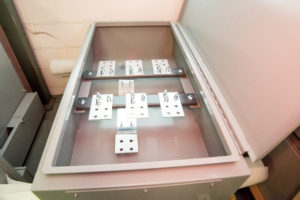 Termination cabinets are a critical part of a electrical distribution infrastructure. Termination cabinets are used in the telecommunications, automation and power engineering fields to house power distribution switchgear and other equipment such as lighting contractors and control gear. Termination cabinets offer protection to the enclosed equipment from harsh outdoor environments and the elements. Enclosures, CT cabinets and termination cabinets must adhere to National and International Standards such as UL 508A for weatherproof quality (so that they are resistant to rain, ice and snow). NEMA 3R enclosures are suitable for both indoor and outdoor applications.
Termination cabinets are a critical part of a electrical distribution infrastructure. Termination cabinets are used in the telecommunications, automation and power engineering fields to house power distribution switchgear and other equipment such as lighting contractors and control gear. Termination cabinets offer protection to the enclosed equipment from harsh outdoor environments and the elements. Enclosures, CT cabinets and termination cabinets must adhere to National and International Standards such as UL 508A for weatherproof quality (so that they are resistant to rain, ice and snow). NEMA 3R enclosures are suitable for both indoor and outdoor applications.
CT and Termination Cabinets Construction
Current transformer and termination cabinets are made from four primary materials, which are:
- Polycarbonate or glass reinforced plastic.
- Aluminium.
- Stainless steel.
- Galvanized steel.
Non-metallic termination and CT cabinets are made using moulds, while precision cutting, bending and welding methods are used to construct and assemble metallic cabinets. The majority of CT cabinets and termination enclosures are also UL listed. In addition to meeting NEMA Type 3r standards, termination boxes must also comply with the specific UL 1773 Standard for termination cabinets.
Physical and functional properties of CT and Termination Cabinets
The NEMA Type 3r Standard requires CT cabinets and termination cabinets to withstand various indoor and outdoor operating environments. These cabinets must be able to withstand falling rain and sleet including ice and snow, if used outdoors. If used indoors, they must provide adequate protection against water ingress.
The construction methods employed by custom metal fabricators go a long way in ensuring the enclosure meet, and often exceed the standard’s requirements. Continuous seam welding, for example, ensures there are no joints which may weaken over time. Using 12, 14 or even 16 gauge thickness sheets of metal also ensure mechanical strength to withstand mechanical and physical damage. Other features contributing to water and dust proof properties include louvres and gaskets or rubber seals around the door edges.
The NEMA 3r characteristics which all CT and termination cabinets should meet are as follows:
- Offer protection against accidental contact with equipment inside.
- Offer protection to contents against falling dirt, sleet, snow and rain.
- Provide drainage provision to prevent pooling of water inside.
- Offer locking and latching mechanisms for safety and security.
Common uses of CT and Termination Cabinets
CT cabinets are designed to house current transformers for a variety of applications. They can also be used for housing electrical submetering. CT cabinets are also suitable for use as wiring boxes, junction or pull boxes.
Termination boxes are commonly used for housing electrical controls and instrumentation. They can also be used as wiring boxes and junction boxes for telephone and communication cable terminations.